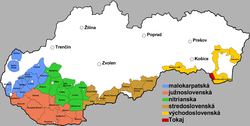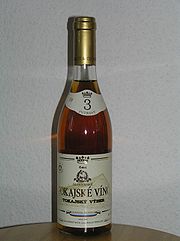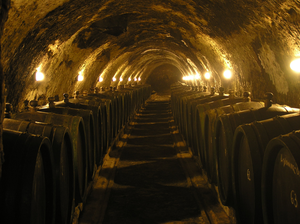.gif)
Tokaj (region in Slovakia)
Encyclopedia


Slovakia
The Slovak Republic is a landlocked state in Central Europe. It has a population of over five million and an area of about . Slovakia is bordered by the Czech Republic and Austria to the west, Poland to the north, Ukraine to the east and Hungary to the south...
which comprises seven communities and 565 hectares of vineyards. This region was originally the northern part of the Tokaj-Hegyalja
Tokaj-Hegyalja
Tokaj-Hegyalja is a historical wine region located in southeastern Slovakia and northeastern Hungary. Hegyalja means "foothills" in Hungarian, and this was the original name of the region....
wine region in the Kingdom of Hungary
Kingdom of Hungary
The Kingdom of Hungary comprised present-day Hungary, Slovakia and Croatia , Transylvania , Carpatho Ruthenia , Vojvodina , Burgenland , and other smaller territories surrounding present-day Hungary's borders...
.
Vintners in the Slovak wine region of Tokaj
Tokaj (region in Slovakia)
Tokajské víno wine is produced in Tokaj, a wine region in Slovakia which comprises seven communities and 565 hectares of vineyards. This region was originally the northern part of the Tokaj-Hegyalja wine region in the Kingdom of Hungary....
may use the Tokaj label (or Tokajský/-á/-é which means “of Tokaj” in Slovak
Slovak language
Slovak , is an Indo-European language that belongs to the West Slavic languages .Slovak is the official language of Slovakia, where it is spoken by 5 million people...
) if they apply the Slovak
Slovakia
The Slovak Republic is a landlocked state in Central Europe. It has a population of over five million and an area of about . Slovakia is bordered by the Czech Republic and Austria to the west, Poland to the north, Ukraine to the east and Hungary to the south...
equivalent of the Hungarian
Hungary
Hungary , officially the Republic of Hungary , is a landlocked country in Central Europe. It is situated in the Carpathian Basin and is bordered by Slovakia to the north, Ukraine and Romania to the east, Serbia and Croatia to the south, Slovenia to the southwest and Austria to the west. The...
quality control regulations.
History of the wine region
Only a small part of the Slovak wine region of Tokaj was once part of the historic TokajTokaj
Tokaj , is a historical town in Borsod-Abaúj-Zemplén county, Northern Hungary, 54 kilometers from county capital Miskolc. It is the centre of the famous Tokaj-Hegyalja wine district where the world famous Tokaji wine is produced.- History :...
wine region of the Kingdom of Hungary
Kingdom of Hungary
The Kingdom of Hungary comprised present-day Hungary, Slovakia and Croatia , Transylvania , Carpatho Ruthenia , Vojvodina , Burgenland , and other smaller territories surrounding present-day Hungary's borders...
. Due to the Treaty of Trianon
Treaty of Trianon
The Treaty of Trianon was the peace agreement signed in 1920, at the end of World War I, between the Allies of World War I and Hungary . The treaty greatly redefined and reduced Hungary's borders. From its borders before World War I, it lost 72% of its territory, which was reduced from to...
the majority of the region (around 28 communities and some 4,500 hectares of vineyards) remained part of Hungary
Hungary
Hungary , officially the Republic of Hungary , is a landlocked country in Central Europe. It is situated in the Carpathian Basin and is bordered by Slovakia to the north, Ukraine and Romania to the east, Serbia and Croatia to the south, Slovenia to the southwest and Austria to the west. The...
and a smaller part (3 communities and about 175 hectares of vineyards) became part of Czechoslovakia
Czechoslovakia
Czechoslovakia or Czecho-Slovakia was a sovereign state in Central Europe which existed from October 1918, when it declared its independence from the Austro-Hungarian Empire, until 1992...
(today Slovakia
Slovakia
The Slovak Republic is a landlocked state in Central Europe. It has a population of over five million and an area of about . Slovakia is bordered by the Czech Republic and Austria to the west, Poland to the north, Ukraine to the east and Hungary to the south...
). In 1959 four more villages were added by Czechoslovak legislation, although these did not comprise part of the historic region.
The dispute between the countries over the right of Slovakia to use the name Tokaj that started in 1958 for its wines was resolved in 2004 - the two countries came to an agreement in June 2004 under which wine produced on 565 hectares of land in Slovakia will be able to use the Tokajský/-á/-é label ("of Tokaj" in Slovak), providing that the Slovaks accept the Hungarian quality control regulations.
With the accession of both Hungary and Slovakia to the European Union, the Tokaj name (including other forms of spelling) was given Protected Designation of Origin
Protected designation of origin
Protected Geographical Status is a legal framework defined in European Union law to protect the names of regional foods. Protected Designation of Origin , Protected Geographical Indication and Traditional Speciality Guaranteed are distinct regimes of geographical indications within the framework...
status. Currently, wine producers from both the Hungarian Tokaj region and the Slovak Tokaj region may use the Tokaj brand name.
The Tokaj vineyard region, with 998 ha, is the smallest of the six vineyard regions of Slovakia. It comprises seven towns in the Trebišov District
Trebišov District
Trebišov District is a district inthe Košice Region of eastern Slovakia.Until 1918, the district was mostly part of the Hungarian county of Zemplín, apart from a small area...
: Bara
Bara, Trebišov District
Bara is a village and municipality in the Trebišov District in the Košice Region of eastern Slovakia.- History :In historical records the village was first mentioned in 1296 as Bary...
, Čerhov
Cerhov
Čerhov is a village and municipality in the Trebišov District in the Košice Region of eastern Slovakia.-Geography:The village lies at an altitude of 123 metres and covers an area of 8.528 km².It has a population of about 820 people.-External links:...
, Černochov
Cernochov
Černochov is a village and municipality in the Trebišov District in the Košice Region of south-eastern Slovakia.-Geography:The village lies at an altitude of 175 metres and covers an area of 6.156 km².It has a population of 221 people.-Ethnicity:...
, Malá Tŕňa
Malá Trna
Malá Tŕňa is a village and municipality in the Trebišov District in the Košice Region of south-eastern Slovakia.-Geography:The village lies at an altitude of 186 metres and covers an area of 9.807 km².It has a population of about 450 people....
, Slovenské Nové Mesto
Slovenské Nové Mesto
Slovenské Nové Mesto is a village and municipality in the Trebišov District in the Košice Region of south-eastern Slovakia.-History:The village is a former suburb of the Hungarian city of Sátoraljaújhely, which was separated from the rest of the city by the border of the newly created...
, Veľká Tŕňa
Velká Trna
Veľká Tŕňa is a village and municipality in the Trebišov District in the Košice Region of south-eastern Slovakia.-Geography:The village lies at an altitude of 178 metres and covers an area of 14.115 km².It has a population of about 480 people....
, and Viničky
Vinicky
Viničky is a village and municipality in the Trebišov District in the Košice Region of south-eastern Slovakia.-Geography:The village lies at an altitude of 100 metres and covers an area of 8.842 km².It has a population of about 520 people.-Facilities:...
.
Wine makers of these communities produce similar wines to those of the Hungarian wine region, across the border (although Hungarian winemakers maintain that the Slovak wines are usually produced using different techniques). Since 2005, the same regulations apply in Slovakia as in Hungary, but there are concerns regarding the quality of wines made in the Slovak region.
The "Designation of origin" dispute
Tokaj wine is, by its unique character, a luxurious commodity with a strong appeal to the international market. In 1918Treaty of Trianon
The Treaty of Trianon was the peace agreement signed in 1920, at the end of World War I, between the Allies of World War I and Hungary . The treaty greatly redefined and reduced Hungary's borders. From its borders before World War I, it lost 72% of its territory, which was reduced from to...
, a small part of the wine region (3 communities and about 175 hectares of vineyards) became part of Czechoslovakia
Czechoslovakia
Czechoslovakia or Czecho-Slovakia was a sovereign state in Central Europe which existed from October 1918, when it declared its independence from the Austro-Hungarian Empire, until 1992...
(today Slovakia
Slovakia
The Slovak Republic is a landlocked state in Central Europe. It has a population of over five million and an area of about . Slovakia is bordered by the Czech Republic and Austria to the west, Poland to the north, Ukraine to the east and Hungary to the south...
).
The dispute started in 1964 when, for the first time, the then Czechoslovakia exported its excessive production of Tokaj wine to Austria, the market that used to be solely supplied with this commodity by Hungary. The conflict of interests was settled in a bilateral agreement according to which Slovakia - at the expense of the Czech beer-related concession on Hungarian part - was only allowed to export its overproduction of Tokaj wine to Hungary (which consequently re-labeled and re-exported it). This agreement expired in 1990 after which date the dispute arose again.
The Tokaj wine total volume production in Slovakia cannot compete with that of Hungary. On the basis of its total vineyard area, it is able to produce the maximum of 20,000 hectolitres of wine per year, roughly 10% of the total production on the Hungarian side.
Tokajsky wines
The Slovak Tokajsky wines, made exclusively from FurmintFurmint
Furmint is a variety of wine grape from the Pontian Balcanica branch of Vitis vinifera, used for white wines. The name Furmint is taken from the word "froment" for the wheat-gold color of the wine it produces. While it is possible that it the grape is native to Hungary, the grape was likely...
, Lipovina
Hárslevelu
Hárslevelű , also called Lipovina , Frunza de tei , Lindenblättriger and Feuille de Tilleul is a grape variety from the Pontian Balcanica branch of Vitis vinifera.The name refers to the "lime leaf" in each of these languages...
and Yellow Muscat (Slovak
Slovak language
Slovak , is an Indo-European language that belongs to the West Slavic languages .Slovak is the official language of Slovakia, where it is spoken by 5 million people...
: Muškát žltý) grapes, are:
- Tokajský FurmintFurmintFurmint is a variety of wine grape from the Pontian Balcanica branch of Vitis vinifera, used for white wines. The name Furmint is taken from the word "froment" for the wheat-gold color of the wine it produces. While it is possible that it the grape is native to Hungary, the grape was likely...
- Tokajská Lipovina
- Tokajský Muškát žltý (Yellow Muscat)
- Tokajské samorodné suché (samorodné derived from a Slovak word meaning "the way it was grown", suché means "dry"): Samorodné wine is set apart from ordinary wine in that it is made from bunches which contain a considerable proportion of botrytised grapes. Because of this, Samorodné is typically higher in extract than ordinary wine.
- Tokajské samorodné sladké (sladké means "sweet")is set apart from ordinary wine in that it is made from bunches which contain a bigger proportion of botrytised grapes.
- Tokajský výber (in HungarianHungarian languageHungarian is a Uralic language, part of the Ugric group. With some 14 million speakers, it is one of the most widely spoken non-Indo-European languages in Europe....
: aszú): This is the wine which made Tokaj world famous. It is a sweet dessert wine made by individually picking botrytised grapes and trampling them in huge vats to form a paste. Must is then poured on the paste and left to soak before the wine is transferred to wooden casks where fermentation in completed. The wines are graded from 2 to 6 putňa , representing the level of sugar and sugar-free extract in the mature wine.
- Tokajská výberová esencia (the Hungarian version is called aszú-eszencia)
- Tokajská esencia-nektár (meaning "essence-nectar")
- Tokajský mášláš (derived from the Hungarian word máslás)
- Tokajský fordítáš (derived from the Hungarian word fordítás)
Characteristics of the wine region

- Soil and microclimate: The Tokaj terrain consists of clay or loess soil on volcanic subsoil. The microclimate is determined by the sunny, south-facing slopes and the proximity of the Tisza and Bodrog rivers, and is conducive to the proliferation of Botrytis CinereaBotrytisBotrytis may refer to:*Botrytis, the anamorphs of fungi of the genus Botryotinia**Botrytis cinerea, a mold important in wine making*Botrytis, the cauliflower cultivar group of Brassica oleracea...
(noble rotNoble rotNoble rot is the benevolent form of a grey fungus, Botrytis cinerea, affecting wine grapes. Infestation by Botrytis requires moist conditions, and if the weather stays wet, the malevolent form, "grey rot", can destroy crops of grapes...
) and the subsequent desiccation of the grapes. - Indigenous grape varieties: FurmintFurmintFurmint is a variety of wine grape from the Pontian Balcanica branch of Vitis vinifera, used for white wines. The name Furmint is taken from the word "froment" for the wheat-gold color of the wine it produces. While it is possible that it the grape is native to Hungary, the grape was likely...
and LipovinaHársleveluHárslevelű , also called Lipovina , Frunza de tei , Lindenblättriger and Feuille de Tilleul is a grape variety from the Pontian Balcanica branch of Vitis vinifera.The name refers to the "lime leaf" in each of these languages...
have been cultivated in the region for centuries and, together with Yellow Muscat and Zeta, are the only grape varieties officially permitted for use in the region. - Cellars: A vast system of cellars has been carved out of solid rock. They provide a constant temperature of around 12 °C and high humidity of around 95%, which are ideal for the aging of TokajiTokajiTokaji is the name of the wines from the region of Tokaj-Hegyalja in Hungary and Slovakia. The name Tokaji is used for labeling wines from this wine district. This region is noted for its sweet wines made from grapes affected by noble rot, a style of wine which has a long history in this region...
wines. - Appellation system: A royal decree in 1757 established a closed production district in Tokaj, the world's first system of wine appellationAppellationAn appellation is a legally defined and protected geographical indication used to identify where the grapes for a wine were grown; other types of food often have appellations as well...
. Vineyard classification began in 1730 and was completed by the national censuses of 1765 and 1772.
See also
- Slovak wineSlovak wineSlovak wine is produced in the southern part of Slovakia, which is divided into 6 wine-producing areas.Although Slovak wines except Tokaj are not well known internationally, they are popular domestically and in neighbouring countries.-Regions:...
- Tokaj-HegyaljaTokaj-HegyaljaTokaj-Hegyalja is a historical wine region located in southeastern Slovakia and northeastern Hungary. Hegyalja means "foothills" in Hungarian, and this was the original name of the region....
(wine region in Hungary) - TokajiTokajiTokaji is the name of the wines from the region of Tokaj-Hegyalja in Hungary and Slovakia. The name Tokaji is used for labeling wines from this wine district. This region is noted for its sweet wines made from grapes affected by noble rot, a style of wine which has a long history in this region...
(Hungarian wines)

